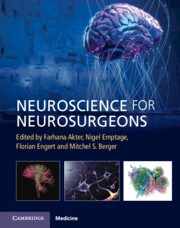Book contents
- Neuroscience for Neurosurgeons
- Neuroscience for Neurosurgeons
- Copyright page
- Contents
- Contributors
- Section 1 Basic and Computational Neuroscience
- Section 2 Clinical Neurosurgical Diseases
- Chapter 12 Glioma
- Chapter 13 Brain Metastases: Molecules to Medicine
- Chapter 14 Benign Adult Brain Tumors and Pediatric Brain Tumors
- Chapter 15 Biomechanics of the Spine
- Chapter 16 Degenerative Cervical Myelopathy
- Chapter 17 Spondylolisthesis
- Chapter 18 Radiculopathy
- Chapter 19 Spinal Tumors
- Chapter 20 Acute Spinal Cord Injury and Spinal Trauma
- Chapter 21 Traumatic Brain Injury
- Chapter 22 Vascular Neurosurgery
- Chapter 23 Pediatric Vascular Malformations
- Chapter 24 Craniofacial Neurosurgery
- Chapter 25 Hydrocephalus
- Chapter 26 Peripheral Nerve Injury Response Mechanisms
- Chapter 27 Clinical Peripheral Nerve Injury Models
- Chapter 28 The Neuroscience of Functional Neurosurgery
- Chapter 29 Neuroradiology: Focused Ultrasound in Neurosurgery
- Chapter 30 Magnetic Resonance Imaging in Neurosurgery
- Chapter 31 Brain Mapping
- Index
- References
Chapter 20 - Acute Spinal Cord Injury and Spinal Trauma
from Section 2 - Clinical Neurosurgical Diseases
Published online by Cambridge University Press: 04 January 2024
- Neuroscience for Neurosurgeons
- Neuroscience for Neurosurgeons
- Copyright page
- Contents
- Contributors
- Section 1 Basic and Computational Neuroscience
- Section 2 Clinical Neurosurgical Diseases
- Chapter 12 Glioma
- Chapter 13 Brain Metastases: Molecules to Medicine
- Chapter 14 Benign Adult Brain Tumors and Pediatric Brain Tumors
- Chapter 15 Biomechanics of the Spine
- Chapter 16 Degenerative Cervical Myelopathy
- Chapter 17 Spondylolisthesis
- Chapter 18 Radiculopathy
- Chapter 19 Spinal Tumors
- Chapter 20 Acute Spinal Cord Injury and Spinal Trauma
- Chapter 21 Traumatic Brain Injury
- Chapter 22 Vascular Neurosurgery
- Chapter 23 Pediatric Vascular Malformations
- Chapter 24 Craniofacial Neurosurgery
- Chapter 25 Hydrocephalus
- Chapter 26 Peripheral Nerve Injury Response Mechanisms
- Chapter 27 Clinical Peripheral Nerve Injury Models
- Chapter 28 The Neuroscience of Functional Neurosurgery
- Chapter 29 Neuroradiology: Focused Ultrasound in Neurosurgery
- Chapter 30 Magnetic Resonance Imaging in Neurosurgery
- Chapter 31 Brain Mapping
- Index
- References
Summary
Spinal cord injury(SCI) is a debilitating problem with a global incidence of 8–246 cases per million and an associated significant increase in healthcare cost. Research generally focuses on two broad categories: minimizing initial insult via modulation of primary and secondary injury cascades, or on novel therapeutic strategies aimed at recovering function. To this end, numerous SCI preclinical models have been developed, and promising clinical trials have arisen as a result, highlighting the importance of choosing the optimal model in relation to one’s scientific question. We highlight relevant spinal cord anatomy, embryology, and the pathophysiology of SCI with a focus on how these factors relate to preclinical models of SCI and spinal cord trauma, and hope to highlight important factors necessary for future research.
- Type
- Chapter
- Information
- Neuroscience for Neurosurgeons , pp. 278 - 290Publisher: Cambridge University PressPrint publication year: 2024



